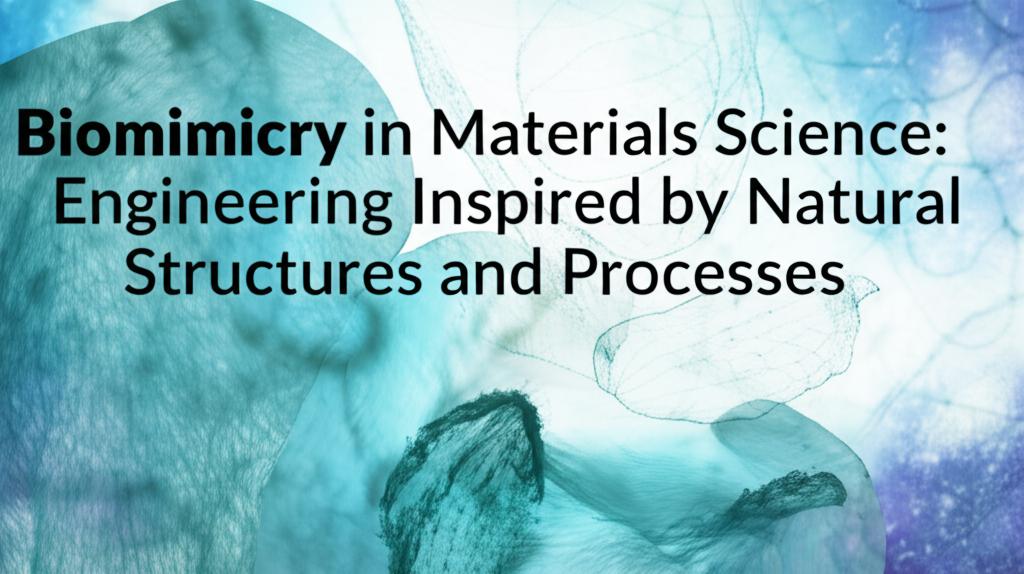Nature, through billions of years of evolution, has developed materials and structures optimized for performance, resilience, and sustainability. Biomimicry in materials science involves studying and emulating these natural designs and processes to create novel materials and technologies that solve human challenges. This approach moves beyond simply copying nature; it requires understanding the underlying principles that make natural materials effective.
Learning from Nature's Toolkit: Core PrinciplesScientists and engineers draw inspiration from several key strategies employed by nature:
- Hierarchical Structures: Natural materials often exhibit intricate structures across multiple length scales (from nano to macro). This hierarchy, like in bone or wood, provides combinations of strength, toughness, and light weight that are difficult to achieve in conventional synthetic materials.
- Multifunctionality: Organisms rarely optimize for a single function. A leaf, for example, performs photosynthesis, manages water, and defends against pests. Biomimicry aims to integrate multiple functions (e.g., self-healing, sensing, energy harvesting) into single materials.
- Self-Assembly: Nature builds complex structures from the bottom up using molecular self-assembly, often under mild conditions (ambient temperature, water as a solvent). Mimicking this could lead to more energy-efficient and sustainable manufacturing processes.
- Adaptability and Responsiveness: Living systems can adapt to changing environments. Developing materials that can change their properties (shape, stiffness, permeability) in response to stimuli like light, heat, or chemical signals is a major goal.
- Self-Healing and Repair: Damage is common in nature, and many organisms possess mechanisms for repair. Incorporating self-healing capabilities into synthetic materials could dramatically extend product lifetimes and reduce waste.
- Resource Efficiency and Sustainability: Natural processes often utilize abundant, locally available resources and operate within closed-loop systems where waste is minimized or reused. Biomimetic materials science frequently aims for greater sustainability and reduced environmental impact.
Numerous examples showcase how natural structures and processes inspire new materials:
- Surface Innovations:
Lotus Effect: The micro/nano-textured surface of the lotus leaf causes water droplets to bead up and roll off, collecting dirt particles. This inspires self-cleaning paints, fabrics, and coatings.
Shark Skin: The unique texture of shark skin reduces drag and inhibits biofouling. This has inspired faster swimsuit designs and research into antimicrobial surfaces for ships and medical devices.
Gecko Adhesion: Geckos cling to surfaces using millions of microscopic hairs (setae) on their feet, creating strong yet reversible adhesion without sticky residue. This principle guides the development of powerful, reusable adhesives ("gecko tape").
Desert Beetle Water Collection: The Namib desert beetle collects fog on its bumpy, waxy back. This mechanism inspires materials and devices for efficient water harvesting from humid air.
- Structural and Mechanical Marvels:
Nacre (Mother-of-Pearl): The layered "brick-and-mortar" structure of nacre makes seashells exceptionally tough despite being made of brittle calcium carbonate. This design informs the creation of strong, fracture-resistant ceramics and composites.
Spider Silk: Stronger than steel by weight and incredibly elastic, spider silk's structure is a target for developing high-performance synthetic fibers for textiles, medical sutures, and lightweight composites.
Honeycomb Structures: Bees use hexagonal cells to create strong, lightweight structures with minimal material. This principle is widely used in aerospace, construction, and packaging for lightweight strength and energy absorption.
Whale Fin Aerodynamics: Tubercles (bumps) on the leading edge of humpback whale flippers enhance lift and reduce drag. This design has inspired more efficient wind turbine blades, fans, and potentially aircraft wings.
- Process and System Mimicry:
Termite Mound Architecture: Some termite mounds maintain stable internal temperatures despite extreme external fluctuations through sophisticated passive ventilation systems. This inspires energy-efficient building designs with natural climate control.
Photosynthesis: Plants efficiently convert sunlight into energy. Research mimics aspects of photosynthesis to develop more efficient solar cells and processes for producing solar fuels.
- Biomedical Applications:
Extracellular Matrix (ECM) Mimicry: Designing scaffolds for tissue engineering that replicate the structure and biochemical cues of the natural ECM to support cell growth, adhesion, and differentiation.
Self-Healing Materials: Inspired by biological repair mechanisms, materials are being developed that can autonomously repair minor damage, crucial for implants or hard-to-reach components.
Recent Advancements and Future DirectionsThe field is rapidly advancing, driven by new tools and a deeper understanding of biology:
- Additive Manufacturing (3D Printing): Allows fabrication of the complex, hierarchical structures found in nature, which were previously difficult or impossible to create.
- Artificial Intelligence (AI) and Machine Learning: Used to analyze complex biological structures, predict material properties, and optimize bio-inspired designs.
- Nanotechnology: Enables manipulation of materials at the nanoscale to replicate the intricate features responsible for many natural material properties.
- Engineered Living Materials (ELMs): Materials that incorporate living cells or biological components, enabling properties like self-growth, self-repair, and adaptation in response to the environment.
- Systems-Level Biomimicry: Moving beyond mimicking individual components to emulating entire natural systems and processes for enhanced sustainability and functionality.
Despite the immense potential, challenges remain:
- Complexity: Fully understanding and accurately replicating the multi-scale complexity and integrated functionality of natural systems is difficult.
- Scalability: Translating intricate lab-scale designs into cost-effective, large-scale manufacturing processes is a significant hurdle.
- Integration: Combining multiple biomimetic functions (e.g., strength, self-healing, sensing) into a single material system remains challenging.
- Sustainability: Ensuring that the materials and processes used to create biomimetic solutions are themselves environmentally friendly and sustainable is crucial.
- Interdisciplinarity: Effective biomimicry requires close collaboration between biologists, materials scientists, engineers, chemists, and physicists.
Biomimicry offers a powerful paradigm shift in materials science, moving from exploiting nature to learning from its time-tested ingenuity. By studying and emulating the structures and processes perfected over millennia, researchers are developing innovative materials with unprecedented performance, efficiency, and sustainability. As our understanding of biology deepens and our technological capabilities advance, nature-inspired materials engineering promises to deliver transformative solutions to pressing global challenges in energy, medicine, construction, transportation, and beyond.

